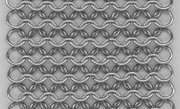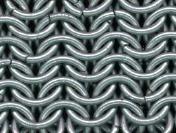Chainmail
|
|
- For other uses, see Chainmail (disambiguation).Missing image
Morgan_Bible_28r_detail.jpg"David rejects the unaccustomed armour" (detail of fol. 28r of the 13th century Morgan Bible)
Chainmail (also chain mail, chain maille, or just mail or maille) is a type of armour that consists of small metal rings put together in a pattern to form a mesh. Mail can generally be punctured by a spear or shorn by the blow from a heavy axe or sword (although riveted chainmail is much stronger), and its flexibility means that its wearer is still vulnerable to blunt weapons. Nevertheless, it was an effective and popular defense for its ability to stop cutting weapons from piercing the skin. Medieval physicians could usually set broken bones, but when it came to preventing infection they were woefully inadequate. Thus the mail was weak in defending against wounds which could be more easily mended but strong against those to which the soldier was most vulnerable.
| Contents |
History
Mail was invented some time in the mid 1st millennium BC, but it is unknown where and by whom it was first used. It may have been invented independently in Japan and in Europe. The earliest finds altogether are from 5th century BC Scythian graves. Etruscan or Celtic examples date to ca. the 3rd century BC. The Roman Empire first came into contact with mail when it invaded Gaul, and the Roman army soon adopted the technology for their secondary troops in the form of the Lorica Hamata. The use of mail was prominent throughout the High Middle Ages, and reached its apex in the 13th century, when full body suits of mail armour were developed.
In the 14th century, plate armour began to replace mail. It could still be seen after this point being worn by those who could not afford plate, however, and it was also common to wear a shirt of mail beneath plate armour to protect the joints and the groin.
Etymology
The word chainmail is a pleonasm: in the Middle Ages and Renaissance, chain was the English name for it, while maille was the common French name for it. This—and the alternative spellings "maile" and "maille"—derive through the Italian maglia, from the Latin macula, meaning "net". The composite term chainmail is a modern recharacterisation (see also titmouse).
Manufacture
Several patterns of linking the rings together have been known since ancient times, with the most common being the 1-to-4 pattern (where each ring is linked with four others). In Europe, the 1-to-4 pattern was almost completely dominant, with 1-to-6 being seen very rarely. In East Asia (primarily Japan), mail was also common, but here several more patterns were utilized and an entire nomenclature developed around them. In the Middle East, yet other patterns were developed and often combined with metal plates linked in with the rings.
Historically, the rings composing a piece of mail would be riveted shut, to reduce the chance of the rings splitting open when subjected to a thrusting attack or a hit by an arrow. Some pieces were made of alternating rows of riveted and solid rings of steel punched from a sheet.
In modern re-enactment (such as that of the Society for Creative Anachronism) and live action role-playing games (LARPs), suits of mail are hand-made from rings of wire. They may or may not be welded or soldered but are rarely riveted. They may also be made of split sprung steel washers. Usually two pairs of pliers are used to bend the washers open and closed while "knitting" the mail. The resulting mail is usually heavier than traditional wire-wound mail.
Modern uses
During World War I, mail was evaluated as a material for bullet proof vests, but results were unsatisfactory as the rings would fragment and further aggravate the damage. A mail fringe, designed by Captain Cruise of the British Infantry, was added to helmets to protect the face but this proved unpopular with soldiers, in spite of being proven to defend against a three-ounce shrapnel round fired at a distance of one hundred yards (92.3m).
Today, there are machines which knit metal wires to produce protective mail, usually with rings welded together, for use in protective clothing for butchers and scuba divers, to protect against meat packing equipment and shark teeth, respectively. There is also anecdotal evidence (http://www.mailleartisans.org/articles/articledisplay.cgi?key=9612) to suggest that mail is superior to heavy leather for protecting motorcyclists from injury should they be thrown from their motorcycles.
Mail also has applications in sculpture and jewelry, especially when made out of precious metals or colorful anodized metals. Recent trends in mail artwork include headdresses, Christmas ornaments, chess sets, and all manner of jewelry. For these non-traditional applications, hundreds of new weaves or patterns have been invented.
Chain mail suits are also used as protection from high voltages - they form a faraday cage around the wearer. Chainmail is widely used in modern meat packing industry to protect workers from sharp saws and blades.
In film
In many films, knitted cloth spray-painted with a metallic paint is used instead of actual chainmail to cut down on cost. Films more dedicated to costume accuracy often use ABS rings, for the lower cost and weight. Thousands of such ABS mail coats were made for the film of The Lord of the Rings. However, in Mad Max Beyond Thunderdome, Tina Turner wore a real metal mail shirt that weighed over 40 pounds.
Links
- Excavated lorica hamata (http://www.armatura.connectfree.co.uk/arma/mail.htm)
- The Construction and Metallurgy of Mail Armour in the Wallace Collection (http://www.wallacecollection.org/i_s/publications/mail_construction.htm) by David Edge
- Article on Erik D. Schmid (http://www.cloudnet.com/~erikdschmid/times.htm)
- Armour Research Society (http://www.armourresearchsociety.org/)
- The Maille Artisans International League (MAIL) (http://mailleartisans.org/)
- http://artofchainmail.com/history.html
- Construction tips
- The Apprentice Armorer's Illustrated Handbook For Making Mail (http://realbeer.com/jjpalmer/HowtoChain.html)
- Chainmail construction page (http://home.t-online.de/home/Tempora-Nostra/eketthm.htm): Chainmail with rings alongside at the torso, arms and neck, with closed underarms
- The Ring Lord Forum (http://www.chainmailstore.com/cgi-bin/forum/ultimatebb.cgi)
- Chainmail Emporium (http://www.chainmailemporium.com/)de:Kettenrüstung
fr:Cotte de mailles he:שריון שרשראות nl:Maliënkolder pl:Kolczuga ru:Кольчуга



